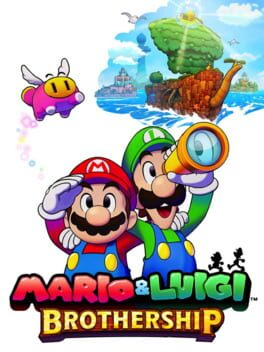▲
2
▼
When the game was first announced, Nintendo did not reveal what company was developing the game, only stating that some former developers from AlphaDream, the company that developed all previous games in the series, were involved. It wouldn't be until the intellectual property notices were discovered that the developer was identified as Acquire, who were best known for developing the Tenchu, Way of the Samurai, and Octopath Traveler series.
▲
2
▼
During an Ask the Developer interview, producer Akira Otani revealed that Nintendo had tried for years to come up with a new path for the Mario & Luigi series following the release of Mario & Luigi: Paper Jam, but nearly gave up after failing to come up with anything. Eventually, the idea of working with Acquire was brought up, and after several discussions with Haruyuki Ohashi (who would go on to direct Brothership), Otani realized the company would be a good fit for bringing the series to 3D. As part of this, it was briefly considered to give the game an HD-2D art style similar to that seen in Octopath Traveler, but this was dropped in favor of keeping the game's visuals in line with the game's cover art.
▲
2
▼
 Within the game's data is an early low-detail model for Shipshape Island with substantial differences compared to the final version. Among other traits, the early model features a much different arrangement of pathways and tablelands, a different design for the Uni-Tree, whose roots arch over the ground and whose top features a cluster of leaves instead of an incandescent lightbulb, a much larger cannon adorned by a bird's nest instead of a telescope, and no cave in the ship's hull.
Within the game's data is an early low-detail model for Shipshape Island with substantial differences compared to the final version. Among other traits, the early model features a much different arrangement of pathways and tablelands, a different design for the Uni-Tree, whose roots arch over the ground and whose top features a cluster of leaves instead of an incandescent lightbulb, a much larger cannon adorned by a bird's nest instead of a telescope, and no cave in the ship's hull.
▲
1
▼
The opening cutscene for the game, which involves Mario and Luigi being separated while travelling through a portal of colorful lights, is notably similar to a scene from the 2023 film "The Super Mario Bros. Movie". During an "Ask the Developer" interview, it was revealed that the similarities were entirely coincidental and that they had no information about the film at the time the cutscene was made, with some of the developers being surprised by the similarities when they watched the film.
▲
2
▼
This is the first game in the Mario & Luigi series to not have music composed by Yoko Shimomura, instead being composed by Hideki Sakamoto. According to an interview with Famitsu, this was done as part of the team's efforts to give the series a "fresh start". However, making new music proved to be a challenge, with series creator Shigeru Miyamoto commenting that the music Sakamoto had originally written for the game sounded "too ordinary". This led to the composers adding more bass into the game's score in an effort to incorporate more "Mario-ness" into the soundtrack.
Related Games
Mario & Luigi: Paper Jam
Mario & Luigi: Partners in Time
Mario & Luigi: Dream Team
Mario & Luigi: Superstar Saga
Mario & Luigi: Bowser's Inside Story
Super Mario RPG 2
Mario Bros.
Super Mario Maker
SSX on Tour
Photos with Mario
Super Mario Party
Nintendo Puzzle Collection
Mario Teaches Typing
Super Smash Bros.
Luigi's Mansion 3
Game & Watch: Super Mario Bros.
Super Mario Bros. 2
Luigi's Mansion
Mario Kart: Super Circuit
Super Mario RPG: Legend of the Seven Stars
Waluigi's Foot Fault
Donkey Kong
Mario vs. Donkey Kong: Tipping Stars
Tetris Attack
Mario Artist: Paint Studio
Mario + Rabbids Sparks of Hope
Mario vs. Donkey Kong: Mini-Land Mayhem!
Super Mario Bros. 35
Mario Kart 8 Deluxe: Booster Course Pass
Super Smash Bros. Ultimate
Princess Peach: Showtime!
Yoshi's Woolly World
Mario's Super Picross
Super Mario RPG
Famicom Mini Collection
Super Mario World 2: Yoshi's Island
Super Smash Bros. Brawl
Mario Is Missing!
Donkey Kong
Mario Party 7
Poochy & Yoshi's Woolly World
Skylanders: SuperChargers Racing
Paper Mario: The Origami King
Mario Bros. Classic Serie
Mario's Early Years! Fun with Letters
Super Mario Land 2: 6 Golden Coins
Mario & Sonic at the Olympic Games
Super Paper Mario
Mario's Cement Factory
Balloon Trip
